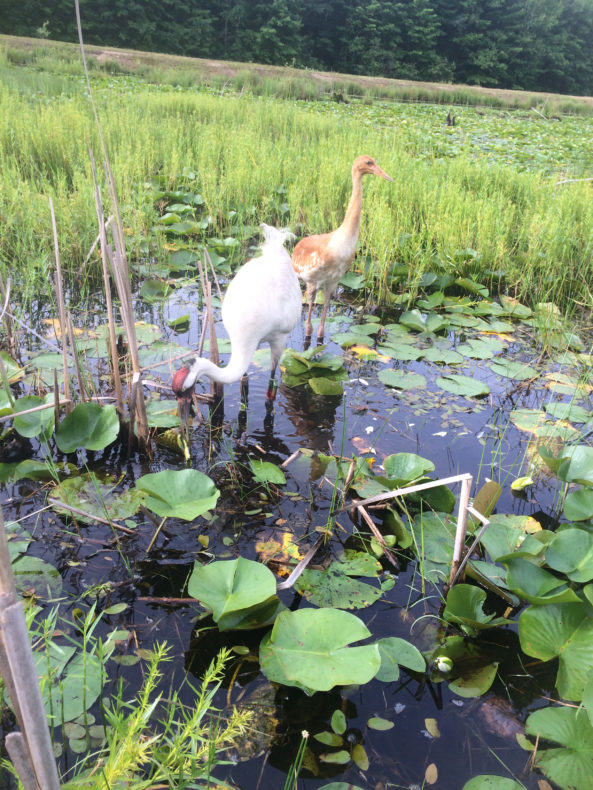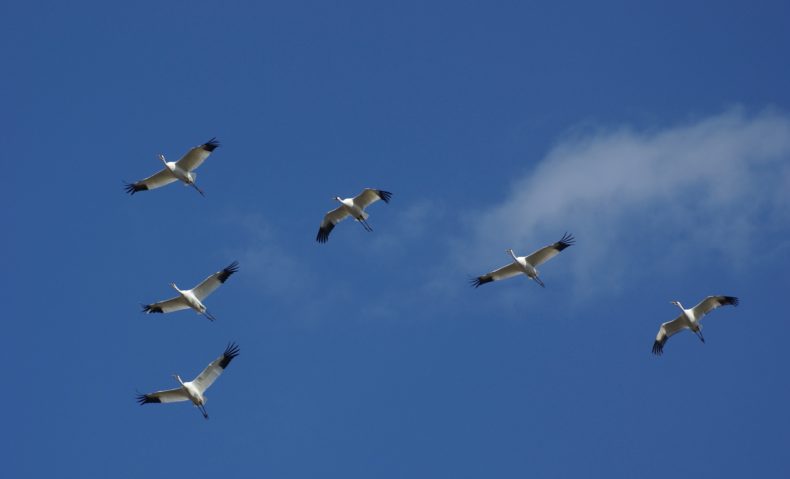The Goose Pond Fish and Wildlife Area, a patch of restored prairie and wetland in southwestern Indiana, is a a favorite stopover for migratory birds and itinerant birders. On January 3, while driving the grid of ruler-straight county roads around the wetland, a birder saw an unmistakable large, white shape: it was a whooping crane, one of the most endangered birds in North America, and it appeared to have been shot dead with a high-powered rifle.
The birder, who happened to be a volunteer with the International Crane Foundation (ICF) in Baraboo, Wisconsin, reported the find to state wildlife officials. The investigation is now in the hands of the U.S. Fish and Wildlife Service, and the crane’s five-foot-tall carcass is under examination at the National Fish and Wildlife Forensics Laboratory in southern Oregon. For the scientists and conservationists who have spent decades trying to coax whooper populations back to self-sustaining numbers, the news of the shooting was crushingly familiar: 33 whooping cranes have been shot and killed in the United States since the year 2000, according to records obtained by Lizzie Condon of ICF. That’s a huge toll on a species with only about 440 free-roaming members.
In most cases, the perpetrators aren’t hunters but target shooters, taking an opportunistic crack at a big, slow, feathered target. Few realize, or admit to realizing, that they had a whooper in their sights. That makes them difficult to prosecute under the Endangered Species Act, which only penalizes those who knowingly violate its provisions. One exception occurred this past fall in Texas, when a teenager who deliberately killed two whoopers (“I’ll shoot them sons of bitches,” he told an acquaintance) was fined more than $25,000 and sentenced to 200 hours of community service, five years’ probation, and a five-year ban on hunting and possession of firearms. To discourage would-be shooters, ICF staff travel whooping-crane migration routes to spread the word about the bird, its appearance, and the laws that protect it, often recruiting conservation-minded hunters as messengers.
Depending on how you look at it, whooping-crane recovery is either an iconic conservation success story or a six-decade-long emergency. Whoopers were probably never very common, and unlike sandhill cranes, which can hang out on dry land and find plenty to eat in farm fields, whooping cranes depend almost exclusively on wetlands for habitat. In the early 1900s, when Midwestern farmers drew on government support and new technology to drain wetlands wholesale, the whoopers lost their migratory rest stops, and the species spiraled rapidly downward, reaching an all-time low of 21 birds in 1944.
wetlands for habitat. In the early 1900s, when Midwestern farmers drew on government support and new technology to drain wetlands wholesale, the whoopers lost their migratory rest stops, and the species spiraled rapidly downward, reaching an all-time low of 21 birds in 1944.
The National Audubon Society, which had been intermittently studying the species, recognized the crisis, and after the end of World War II its leaders pleaded with the U.S. Fish and Wildlife Service to help save the whooper. The society believed the bird could be rescued with stricter hunting restrictions and habitat protection; government biologists argued that captive breeding, though risky and unreliable, was necessary. “We ain’t talking about semi-wild enclosures,” agency biologist John Lynch wrote in a characteristically colorful memo to his superiors in 1955. “In fact, we are not even talking about ‘Wildlife Management.’ What is needed right now is an emergency, high-intensity period of ‘Poultry Husbandry.'”
The Fish and Wildlife Service established a permanent captive breeding facility for whooping cranes along the Patuxent River in Maryland in 1965, and birds continue to be born and raised there for release. The number of free-flying whoopers on the continent has grown since the program began, but slowly, and in many respects, whooping cranes must still be husbanded, not managed. (Young birds are no longer taught to migrate via ultralight aircraft, as they famously used to be, but raising and releasing a whooper remains an intensive, iffy undertaking.)
The bird killed in Indiana last week, known as 4-11, was born at Patuxent in 2009, released in Wisconsin, and led to her Florida wintering grounds by ultralight. She hatched her first chick this past summer in Wisconsin, raising it on her own after her mate died for unknown reasons. She was one of only about 100 migratory whoopers in the eastern United States. Anne Lacy of ICF estimates that 4-11 represented a $100,000 investment of money and effort—and was of incalculable value of the future of the species.
Which is not to say that people shouldn’t keep trying to fully recover the whooping crane. They should. But the species should also serve as a reminder of how difficult—and expensive, and frustrating—it can be to bring a species back from double digits. The Fish and Wildlife Service biologists were probably right to argue for captive breeding of the whooper, for without it, the species would have almost surely gone the way of the passenger pigeon. But many of those same biologists went on to play a central role in the development of the Endangered Species Act, and historians have argued that their intensive-care mindset helped make the law what it is today: one that’s pretty good at preventing extinction, but not very good at helping species thrive, or at heading off crises in the first place.
In 1932, as the whooping crane was quietly slipping toward oblivion, the suffragette, conservationist, and bird lover Rosalie Edge observed that “the time to save a species is while it is still common.” Her point is as sensible now as it was then—and fortunately, the whooper is still around to remind us.
Top: Whoopers aloft over Goose Pond Fish and Wildlife Area. Photo by Jerry Downs. Bottom: 4-11 and her chick in Wisconsin, in happier times. Photo by Hillary Thompson, courtesy of the International Crane Foundation.
